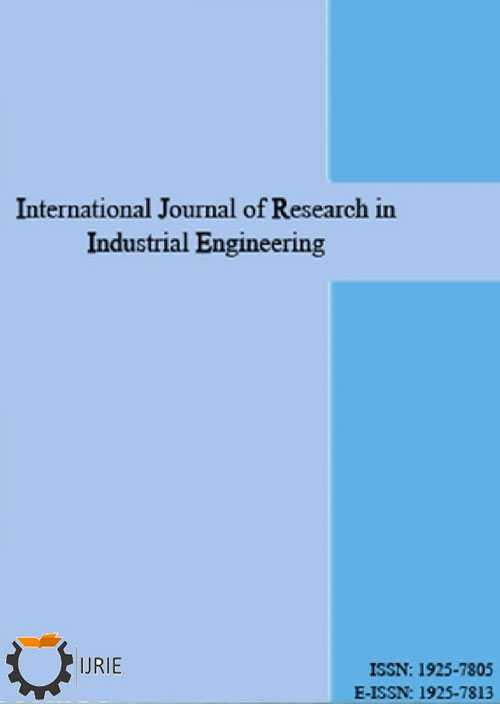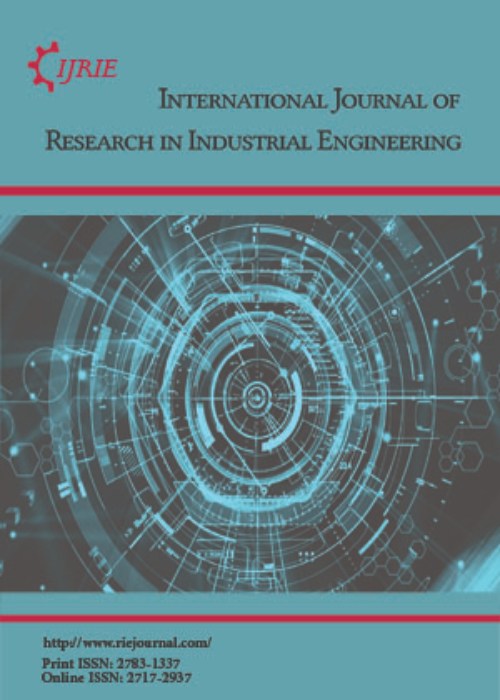فهرست مطالب

International Journal of Research in Industrial Engineering
Volume:9 Issue: 3, Summer 2020
- تاریخ انتشار: 1399/06/28
- تعداد عناوین: 7
-
-
Pages 209-215Acridoidea Stirred Artificial Bee Colony (ASA) Algorithm is applied to solve the power loss reduction problem. In the projected algorithm natural Acridoidea jumping phenomenon has been imitated and the modeled design has been intermingled with artificial bee colony algorithm. In the proposed algorithm, the position update has been done through the distance of jumping done by Acridoidea. The distance (D) is horizontal (h) with angle (θ), velocity (V) parameter amplifying the rate which is based on the gravity of Ballistic projectile. Normally, the angle will be 45◦ horizontal and it depends on the take-off velocity. ASA algorithm has been tested in standard IEEE 57 bus test system and results show that the proposed ASA algorithm reduced the real power loss effectively.Keywords: Optimal reactive power, Transmission Loss, Acridoidea stirred Artificial Bee Colony Algorithm
-
Pages 216-234Compatibility with the environment is one of the important factors in designing a supply chain system, which is also called the “green supply chain”. Similar to the supply chain, green suppliers are very important players in the green supply chain. This paper studies both selection of suppliers and optimal order allocation to them. Despite previous studies, we consider both strategic and operational decisions into the problem. Firstly, we investigate the relevant criteria in selecting suppliers, and assign appropriate weights to suppliers. Then, we apply the fuzzy TOPSIS technique to asses and rank the suppliers. Finally, we investigate optimal allocation of order to the suppliers. For this reason, a two-objective mathematical model is developed. To solve the model, “weighting” and “ɛ-constraint” methods will be investigated, followed by a sensibility analysis to study the changes in the problem’s parameters. The proposed approach is important because it models the strategic and operational decision simultaneously.Keywords: Green Supply Chain Management, green supplier selection, Optimal order allocation, Multi-objective supplier selection
-
Pages 235-246Breast cancer has been the riskiest malignancy among ladies around the world. Nearly 2 million new cases were diagnosed in 2018. The main problem in the detection of breast cancer is to find how tumors turn into malignant or benign and we can do this with the help of machine learning techniques as they provide an appropriate result. According to research, an experienced physician can diagnose cancer with 79% accuracy while using machine learning techniques provides an accuracy of 91%. In this work, machine learning techniques have been applied which include K-Nearest Neighbors algorithm (KNN), Support Vector Machine (SVM), and Decision Tree Classifier (DT). To predict whether the cause is benign or malignant we have used the breast cancer dataset. The SVM classifier gives more accurate and precise results as compared to others, and this classifier is trained with the larger datasets.Keywords: Machine Learning, K-Nearest Neighbors, Support Vector Machine, Decision Tree Classifier, Jupyter
-
Improvement of the student-teacher learning interface with selecting and designing a teaching methodPages 247-259This Research work explores the effective teaching method using a single case study design and produces a plenty of information about students requirements, teachers recommendations and some teaching methods and learning styles .The resulting analysis provides a complete teaching method that may develop teacher student learning interface as well as may satisfy both student’s requirements and the recommendations of teacher. The analysis also specifies the component essential to develop the relationship between teacher and students as well as the learning environment. In this analysis at first some literature review is done to know the aspects of teaching and learning methods and also different types of teaching and learning methods. From this it is easy to understand what should be the focus of learning and the strategy that can help students to empower themselves with their own thinking power .Then the survey is done among 250 students of Rajshahi University of Engineering and Technology to know the students requirements and teachers recommendation is also brought from the discussion with the teachers of this institute. After that according to the students requirements and teachers recommendation the candidates of teaching method is selected. And finally the Fuzzy Topsis Set Theory is applied to find out the effective teaching method which satisfies the student requirements. The characteristics and advantages are also mentioned which are able to alleviate the gaps that exist in the previous teaching methods.Keywords: Teaching method, Learning style, Quality function deployment, Fuzzy TOPSIS
-
Pages 260-270There are currently two ways to vote in India. They are secret ballots and electronic vote machines, but these two processes have some limitations or disadvantages. The current system is also insecure. Many people miss the opportunity to vote simply because they need to go to the polling station and wait for several places to vote. In this paper, we proposed a voting method. In our method, the voting process has three security stages. The first stage is facial recognition, the second stage is Election ID (EID) number verification, and the third stage is One-Time-Password (OTP) verification using the user's mobile phone number registered.Keywords: Smart Voting System, Facial Recognition, OTP, Voter Id, winning party, Python, OpenCV
-
Pages 271-285During the past years, extensive studies have been performed on concretes containing rice husk ash and recycled aggregates, which have shown the advantages of those concretes. Comparison of recycled concrete materials from the aggregates of quarrying plants for use in laboratory mixtures is the difference between this study and previous studies in this field. In addition to mechanical tests and evaluation of the performance of recycled concrete and comparison of ordinary concrete, the evaluation of the design economy and environmental protection are also examined. The main purpose of this study is to achieve and introduce the most optimal conditions for the use and application of recycled stone materials in concrete production. Evaluate and compare the effectiveness of each of the hardened concrete parameters such as mechanical properties and engineering properties (compressive and tensile strength) as a result of using recycled aggregate replacement values, as well as conserving environmental resources that are non-renewable in many industries. Or renewed over very long periods of time, reducing construction waste and environmental pollution, creating employment and economic benefits are other goals pursued in this study.Keywords: mechanical performance, Rice Husk Ash, Microsilica, Recycled grain, Compressive, tensile strength of concrete
-
Pages 286-303Process capability indices are widely used to assess whether the outputs of an in-control process meet the specifications. The commonly used indices are , , and . In most applications, the quality characteristics are assumed to follow normal distribution. But, in practice, many quality characteristics, e.g. count data, proportion defective etc. follow Poisson or binomial distributions, and these characteristics usually have one-sided specification limit. In these cases, computations of or using the standard formula is inappropriate. In order to alleviate the problem, some generalized indices (e.g. index, index, index and index) are proposed in literature. The variant of these indices for one-sided specification are and , and ¸ and , and respectively. All these indices can be computed in any process regardless of whether the quality characteristics are discrete or continuous. However, the same value for different generalized indices and or signifies different capabilities for a process and this poses difficulties in interpreting the estimates of the generalized indices. In this study, the relative goodness of the generalized indices is quantifying capability of a process is assessed. It is found that only or gives proper assessment about the capability of a process. All other generalized indices give a false impression about the capability of a process and thus usages of those indices should be avoided. The results of analysis of multiple case study data taken from Poisson and binomial processes validate the above findings.Keywords: Generalized PCI, Goodness of generalized PCI, normal process, Poisson Process, binomial process


